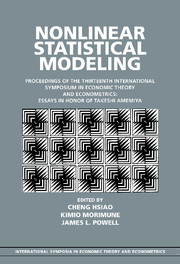 Nonlinear Statistical Modeling
Nonlinear Statistical Modeling Published online by Cambridge University Press: 05 June 2012
Introduction
Consider a population each of whose members is described by a vector of covariates z and a binary response y. A common problem of empirical research is to infer the conditional response probabilities P(y|z) when the population is divided into response strata and random samples are drawn from one or both strata. This sampling process is known to epidemiologists studying the incidence of disease as case-control, case-referent, or retrospective sampling, and has been prominent in epidemiological research since the work of Cornfield (1951). The same sampling process in known to economists studying individual behavior as choice-based sampling (Manski and Lerman 1977) or as responsebased sampling (Manski 1986). The final synonym will be used here.
Sampling from the stratum with y = 1 reveals the distribution P(z | y = 1) of covariates within this stratum. Sampling from the stratum with y = 0 reveals P(z | y = 0). So response-based sampling raises this basic inferential question: What does knowledge of P(z | y = 1) and/or P(z | y = 0) reveal about P(y | z)?
Analysis of response-based sampling has concentrated on situations in which the empirical researcher is able to draw random samples from both response strata, and thus learns both P(z | y = 1) and P(z | y = 0). The epidemiological and econometrics literatures have emphasized the identifying power of auxiliary information on the distribution of response and covariates. These literatures have, however, differed in important ways.
To save this book to your Kindle, first ensure [email protected] is added to your Approved Personal Document E-mail List under your Personal Document Settings on the Manage Your Content and Devices page of your Amazon account. Then enter the ‘name’ part of your Kindle email address below. Find out more about saving to your Kindle.
Note you can select to save to either the @free.kindle.com or @kindle.com variations. ‘@free.kindle.com’ emails are free but can only be saved to your device when it is connected to wi-fi. ‘@kindle.com’ emails can be delivered even when you are not connected to wi-fi, but note that service fees apply.
Find out more about the Kindle Personal Document Service.
To save content items to your account, please confirm that you agree to abide by our usage policies. If this is the first time you use this feature, you will be asked to authorise Cambridge Core to connect with your account. Find out more about saving content to Dropbox.
To save content items to your account, please confirm that you agree to abide by our usage policies. If this is the first time you use this feature, you will be asked to authorise Cambridge Core to connect with your account. Find out more about saving content to Google Drive.